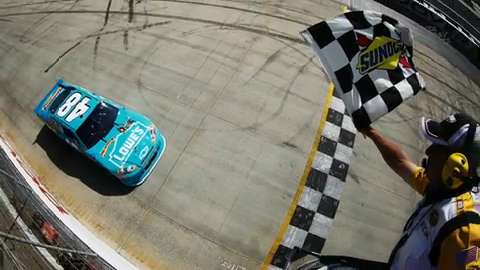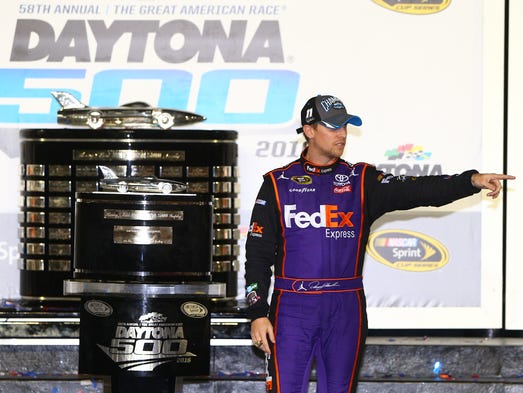Gluck: Chase takes the thunder out of NASCAR’s regular season – USA TODAY

USA TODAY Sports’ Jeff Gluck previews the top story lines at the upcoming AAA 400 Drive for Autism.
usa today sports
As the freshness of the new NASCAR season wears off, there’s renewed concern over the Chase for the Sprint Cup’s impact on the first two-thirds of the schedule.
This is the third year of the playoff’s win-to-get-in format, where drivers essentially clinch a Chase berth as soon as they take the checkered flag. And at times, it seems to have starved the regular season of some drama and storylines fans once anticipated as summer approached.
The format was born out of NASCAR’s desire to put a greater emphasis on winning, and it’s done just that. Drivers have 26 races to get one playoff-clinching victory, so there’s less talk about having a “good points day.”
Officials had grown tired of the points-racing mentality because they suspected drivers were occasionally settling for solid finishes instead of going all-out for victories. And judging by how the Chase for the Sprint Cup has unfolded in recent years — with drivers rising in big moments — there’s reason to believe they were right.
But in the regular season, the format may not be having the intended effect. As it turns out, it’s not necessarily a good thing to emphasize winning when a small group of drivers is hogging all the victories.
Four drivers have combined to win nine of the 11 races this season. And when a driver wins for the second time (or third, in Kyle Busch’s case), it can feel like something is missing.
And there it is, folks! He’s done it! Jimmie Johnson has won the race and clinched a berth in … oops, never mind, he was already in the Chase due to an earlier victory this season.
In the last seven races, only two new drivers have earned their way into the Chase. That’s deflating when the format is geared toward encouraging viewers to watch and see who makes the playoff next.
NASCAR had hoped for many more winners, with drivers constantly clinching Chase berths and narrowing the amount of positions available to fall back on points (there are 16 spots that have to be filled one way or the other). That, officials figured, would be the storyline that carried the sport from week to week.
In turn, the points storyline was all but eliminated for this stage of the season. If a driver is high in points but doesn’t have a win, everyone figures he’ll probably get a victory soon. If a driver is low in points and outside of the top 16 playoff spots, then no worries, there are plenty more races ahead, and all it takes is one win.
That deprives the sport of an interesting angle. For example: If the original Chase format was being used, new faces like Austin Dillon and rookies Chase Elliott and Ryan Blaney would all be tracked week-to-week to see if they could maintain their positions in the top 16. But that doesn’t get much discussion, because points are somewhat irrelevant until the Chase gets closer and it becomes clearer how many spots will be available for those without a win.
It all seems to have interrupted the flow of the regular season. Each race stands on its own (Who won?) instead of generating multiple storylines that can carry over from week to week (Who needs a solid run at the next track? Who is in good shape for the Chase?).
In reality, points racing for the first 26 events might not be such a bad thing. It might give a fan whose driver already has a win more of a reason to keep tuning in each week.
But in today’s NASCAR, the points-racing ship has seemingly sailed — with a Viking funeral, at that.
So the focus turns to smaller tweaks. What can NASCAR do to restore some of the week-to-week storylines?
Drivers want to race for something. It’s not enough for NASCAR to award three bonus points in the Chase for each regular-season win; it would be nice to have a carrot for drivers to pursue over 26 weeks.
Brad Keselowski told reporters at Team Penske’s shop this week he believes there’s a lack of incentive for drivers who have early-season wins. And since it’s “never a good thing to remove motivation from the field,” Keselowski said the drivers’ council has floated some solutions to NASCAR.
“Clearly the sport is lacking some motivation once you’ve won a race,” he said. “I don’t think there’s any question that most of the competitors in the sport feel like that’s maybe not advantageous for the product we’re trying to put on.”
It doesn’t have to be much, but right now the regular-season points leader gets less of a reward than a 6-year-old’s participation trophy in youth soccer. Giving drivers something to chase before the Chase wouldn’t be a dramatic change, but it would be a small tweak to make the regular season more interesting.
Follow Gluck on Twitter @jeff_gluck
PHOTOS: 2016 Sprint Cup race winners

















